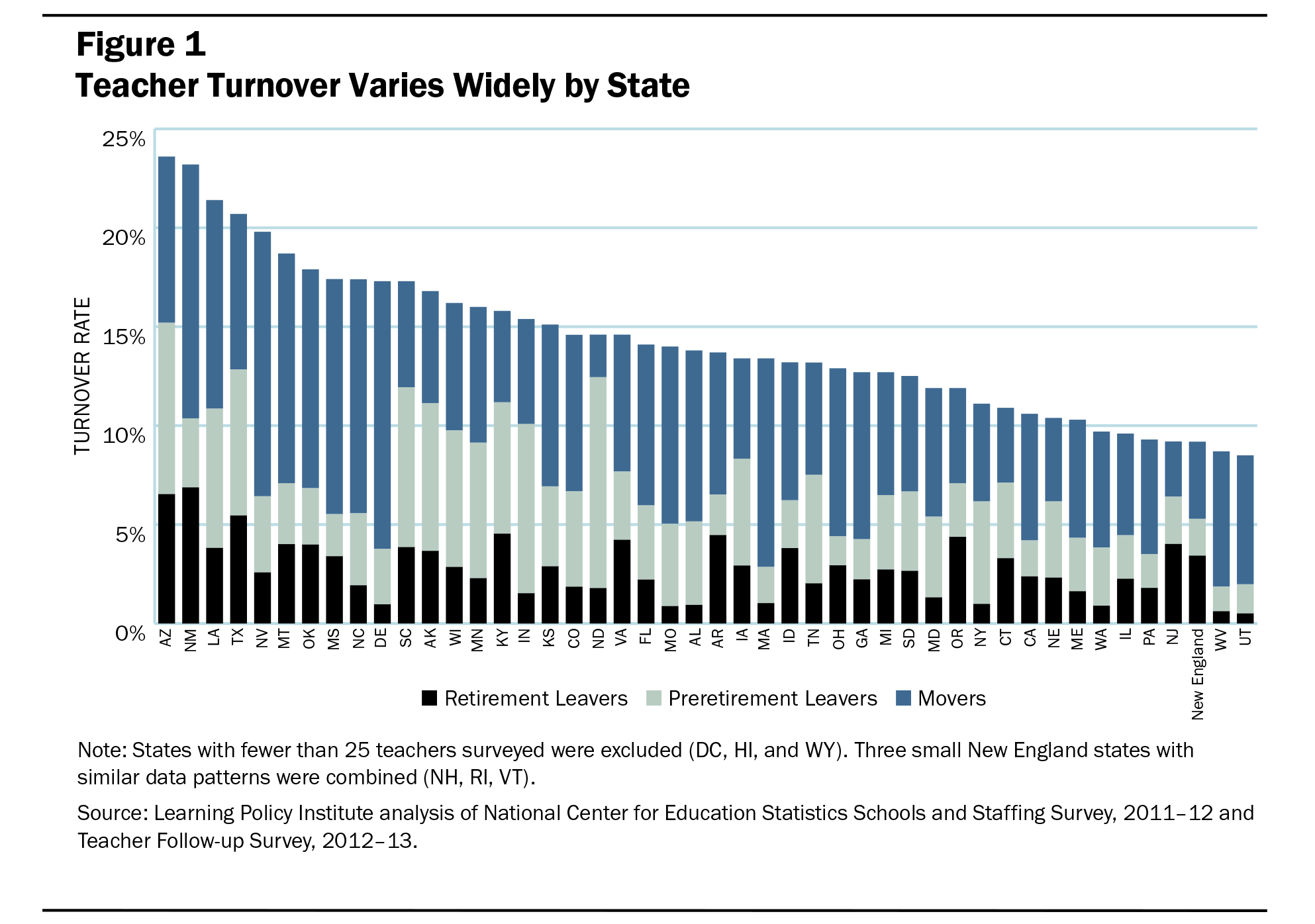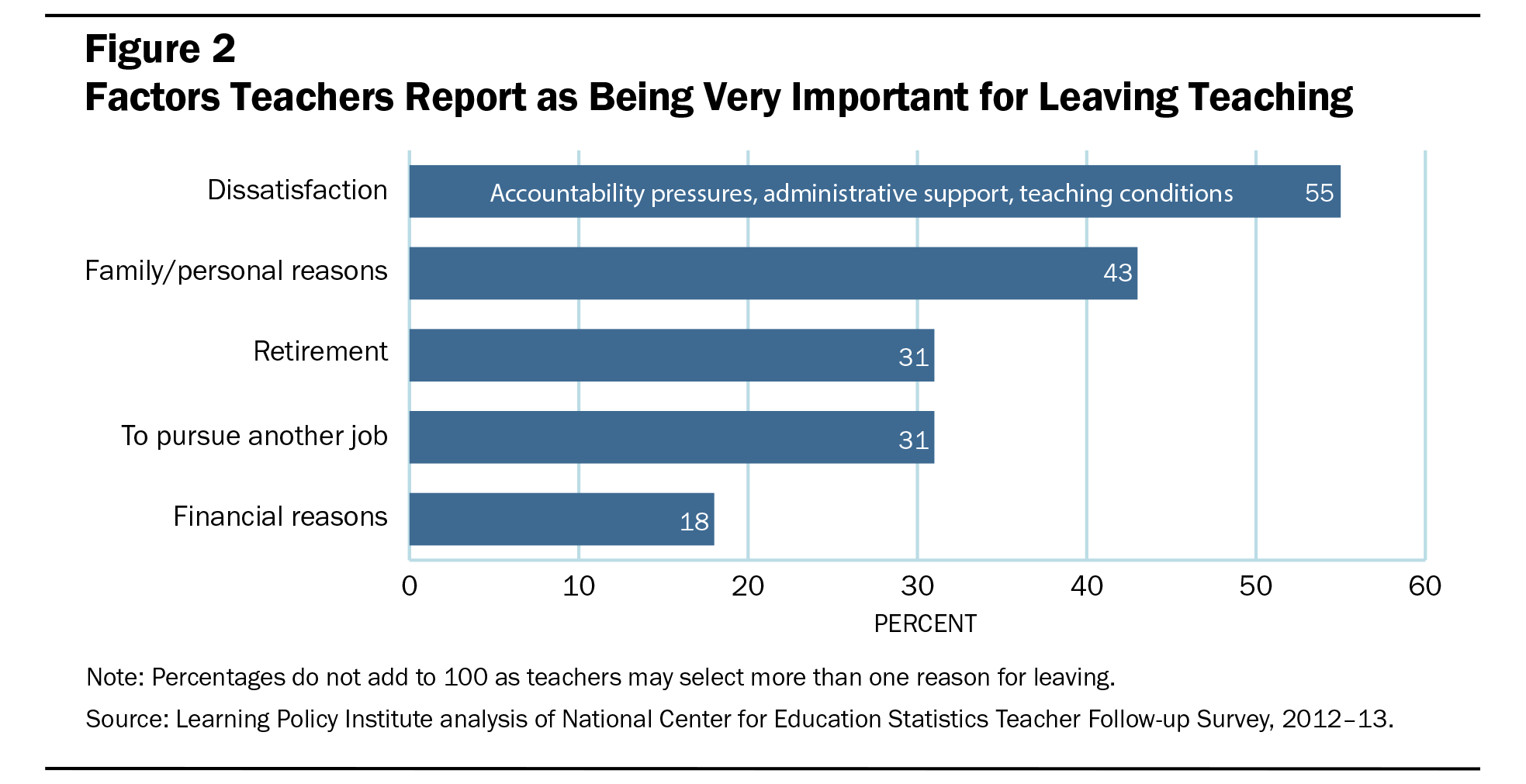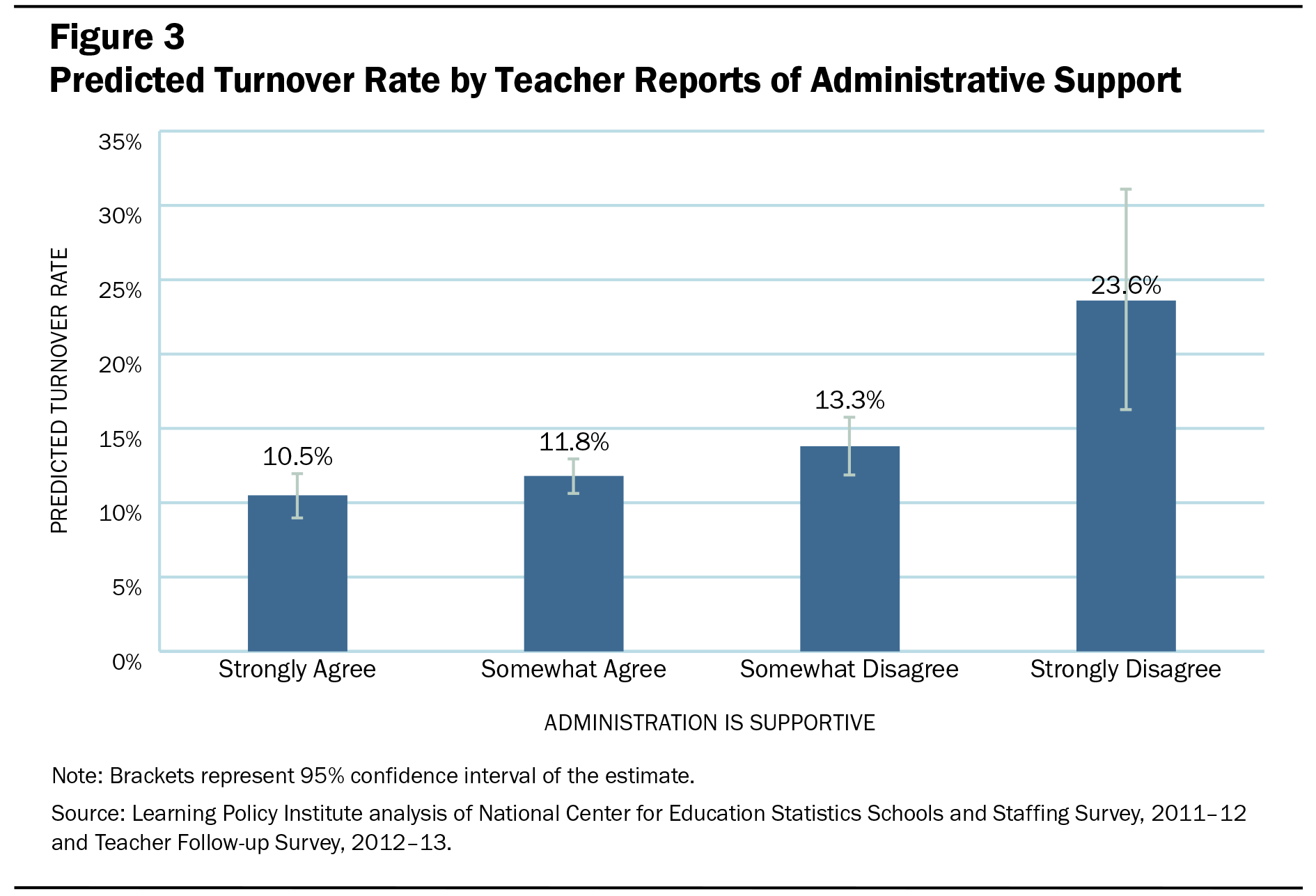Teacher Turnover: Why It Matters and What We Can Do About It

Summary
Without changes in current policies, U.S. teacher shortages are projected to grow in the coming years. Teacher turnover is an important source of these shortages. About 8% of teachers leave the profession each year, two-thirds of them for reasons other than retirement. Another 8% shift to different schools each year. In addition to aggravating teacher shortages, high turnover rates lower student achievement and are costly for schools. This brief examines turnover trends and causes. It concludes that policies to stem teacher turnover should target compensation, teacher preparation and support, and teaching conditions.
As students return to school this fall, many will be taught by teachers untrained for the classes they are teaching. Last year, more than 100,000 classrooms were filled with underprepared teachers, and that number is expected to rise.A 2016 analysis of national teacher supply and demand data projected that the United States could experience a shortage of as many as 100,000 teachers by 2017. See Sutcher, L., Darling-Hammond, L., & Carver-Thomas, D. (2016). A coming crisis in teaching? Teacher supply, demand, and shortages in the U.S. Palo Alto, CA: Learning Policy Institute. This estimate appears close to the reality experienced by districts. A recent LPI review of state teacher workforce reports reveals that, in 35 states that reported such data in either 2015–16 or 2016–17, at least 80,000 positions were not filled by a fully certified teacher. Assuming the same rates of shortages in the remaining 15 states and the District of Columbia (3.5% of teaching positions), the national total of uncertified teachers in 2015–16 or 2016–17 would be approximately 110,000. State laws typically specify that such teachers can only be hired or so assigned if a fully certified teacher is not available. This number understates total shortages because some states only report undercertified teachers in core academic areas, not in all subjects, and because districts also address shortages by canceling courses, increasing class sizes, or starting school with substitute teachers. For example, Florida does not report the number of uncertified teachers in the state, but reported 2,111 vacancies on the first day of school in 2016–17 and projects 6,628 vacancies at the start of school in 2017–18. Other students will face course cancellations, and some will attend larger classes because qualified teachers could not be found. Teacher shortages, which have been growing since 2015, compromise student learning in these and other ways.
Many policymakers have focused on recruiting new teachers to address the national shortage, but curbing teacher turnover is equally important. Unlike Finland and Singapore, where 3–4% of teachers leave the profession each year, usually for retirement, in the United States annual teacher attrition is about 8% and accounts for roughly 90% of the demand for new teachers. Teacher attrition in the United States has increased steeply since the 1990s, when it was only 5%, and two-thirds of those who leave the profession each year do so for reasons other than retirement. Another 8% of teachers shift to different schools each year, bringing the total turnover rate—the combination of those who move schools or leave the profession—closer to 16% of the total teacher workforce.
In addition to aggravating teacher shortages, high turnover rates create extra costs for schools, with estimates reaching $20,000 or more for every teacher who leaves an urban district. Although some teacher turnover is expected and can be beneficial, high turnover rates reduce student achievement—not only for students whose classrooms are directly affected, but also for other students in the school.Ronfeldt, M., Loeb, S., & Wyckoff, J. (2013). How teacher turnover harms student achievement. American Educational Research Journal, 50(1), 4–36.
This brief summarizes a report using data from the most recent nationally representative survey of U.S. teachers—the 2012 Schools and Staffing Survey and the 2013 Teacher Follow-up Survey—to investigate how turnover trends vary across regions, schools, teachers, and subject areas, and what factors predict teachers’ decisions to leave their school or the profession.Carver-Thomas, D., & Darling-Hammond, L. (2017). Teacher turnover: Why it matters and what we can do about it. Palo Alto, CA: Learning Policy Institute.
Variations in Turnover Rates
The survey data reveal that teacher turnover rates vary markedly across the country. Annual turnover rates are highest in the South (16%) and lowest in the Northeast (10%), where states tend to offer higher pay, support smaller class sizes, and make greater investments in education. For most regions, turnover is higher in cities than in any other district type. In the West, however, turnover is highest in towns and rural areas.
Turnover also varies widely across states (see Figure 1), with rates above 20% annually in Arizona, Louisiana, New Mexico, and Texas, and rates below 10% in Illinois, New Jersey, Pennsylvania, Utah, Washington, West Virginia, and a set of New England states (New Hampshire, Rhode Island, and Vermont) combined for this analysis because of their individual size. These differentials tend to be associated with salaries and working conditions.Sutcher, L., Darling-Hammond, L., & Carver-Thomas, D. (2016). A coming crisis in teaching? Teacher supply, demand, and shortages in the U.S. Palo Alto, CA: Learning Policy Institute. See also the web page Understanding teacher shortages: A state-by-state analysis of the factors influencing teacher supply, demand, and equity (2016, September 9).

Turnover rates also vary by subject area. Across the nation, districts have faced severe shortages of qualified teachers in mathematics, science, special education, and English language development. The survey data show that teachers in these fields (along with foreign languages) are more likely to leave their school or the profession than are teachers in other fields. These teachers often have better paying opportunities outside of education. High turnover rates can intensify these subject area shortages, especially in hard-to-staff schools with limited resources. Holding constant several student, teacher, and school characteristics, mathematics and science teachers have a predicted turnover rate that is 37% greater than the rate for elementary teachers. For special education teachers, the turnover rate is 46% higher, and for foreign language teachers, the rate is 87% higher.
School characteristics are also associated with high turnover rates. Teachers are more likely to leave schools that have lower salaries and less-desirable working conditions. Too often, these conditions exist in schools with more students of color and more students from low-income households. Turnover rates are 70% higher for teachers in schools serving the largest concentrations of students of color and nearly 50% higher for teachers in Title I schools, which serve more low-income families. These schools are staffed by teachers with fewer years of experience and, in many cases, significantly less training. Turnover rates in these schools are even higher in key shortage fields, such as mathematics, science, and special education. Turnover rates for mathematics and science teachers are nearly 70% greater in Title I schools than in non-Title I schools. Mathematics and science teacher turnover is 90% greater in the top quartile of schools serving students of color than in the bottom quartile.
Turnover rates are also extremely high for alternatively certified teachers in schools serving the greatest concentration of students of color; 20% of teachers in these schools leave annually.
About one in four of the first-year teachers surveyed—and about 15% of all teachers surveyed—had entered teaching through an alternative pathway, which typically requires that teachers train on the job while they are teaching, often with little or no opportunity for student teaching prior to entry.
Most of these teachers work in the quartile of schools serving the most students of color, and they are 150% more likely to leave these schools than those teachers in schools with the fewest students of color. All in all, students in schools with mostly students from low-income households and students of color are more likely to experience a revolving door of underprepared and less experienced teachers.
Teachers of color, who made up 18% of the public school workforce in 2012 and are twice as likely to enter teaching through an alternative pathway, have higher turnover rates than White teachers overall. This difference is substantially due to the high-need schools in which they work. Three in four teachers of color teach in the quartile of schools with the most students of color, which are often under-resourced and contend with challenging teaching conditions. When teachers of color and White teachers work in schools with the same proportion of students of color, their turnover rates are comparable.
Why Do Teachers Leave Their Jobs?
When asked, teachers cited numerous reasons for leaving their schools or the profession (see Figure 2). Various dissatisfactions with teaching were cited by 55% of those who left the profession and 66% of those who switched to another school. The most frequently cited reasons were:
- Dissatisfaction with testing and accountability pressures (listed by 25% of those who left the profession). With the advent of No Child Left Behind, which often included sanctions such as school closures or staff firing for schools whose scores did not improve rapidly enough, teachers in low-performing schools were especially subject to pressures to “teach to the test” and threatened with loss of their schools or jobs, which produced disincentives for those teaching students in need of more academic support.
- Lack of administrative support (listed by 21% of those who left the profession). Holding all else constant, when teachers strongly disagreed that their administration was supportive, they were more than twice as likely to leave their school than when they strongly agreed that their administration was supportive.
- Dissatisfaction with the teaching career (listed by 21% of those who left). Specific dissatisfactions included their teaching assignments, lack of opportunities for input, and lack of opportunities for advancement.
- Dissatisfaction with working conditions, including large class sizes (10%) and lack of other resources and facilities (9%).

Multiple reasons could be cited in the survey. Beyond the dissatisfactions noted above, personal and financial reasons were also cited by 43% of leavers, along with desires to take another kind of job or to retire (31% in each case).
When we looked at predictors of teacher turnover after controlling for a wide range of student, teacher, and school factors, we found that teacher preparation, administrative support, and salaries were important factors predicting turnover. Those who entered the profession through an alternative certification program were 25% more likely to leave their schools than were full-time teachers who entered through a regular certification program, holding all else constant. Mathematics and science teachers, as well as teachers of color, were more likely to enter teaching through an alternative route, which exacerbates their higher turnover rates.
In addition, those who strongly disagreed that they had supportive administrations were more than twice as likely to leave as those who felt supported (see Figure 3). While beginning salaries were not a significant factor, teachers in districts with the highest maximum salaries were significantly less likely to leave their schools.
In sum, teachers in districts with the strongest salary scales, those who are better prepared, and those who feel the most supported by their school leaders are least likely to leave their schools or teaching altogether.

Policy Recommendations
To stem teacher attrition, policymakers should consider improving the key factors associated with turnover: compensation, teacher preparation and support, and school leadership that influences teaching conditions.
Compensation
Almost one in five teachers who leave the profession cites financial reasons as very important or extremely important. Teacher salaries have declined since the 1990s, and one report found that in 30 states, a teacher with 10 years of experience who supported a family of four would qualify for several forms of government assistance.Boser, U., & Straus, C. (2014). Mid- and late-career teachers struggle with paltry incomes. Washington, DC: Center for American Progress. To address this issue, policymakers should provide compensation packages that are equitable across districts and competitive with those of other occupations requiring similar levels of education.
Policymakers could also offer service scholarship and loan forgiveness programs that reduce the debt burden of becoming a teacher. Research shows that potential debt burdens influence college students’ decisions about which professions to enter.Podolsky, A., & Kini, T. (2016). How effective are loan forgiveness and service scholarships for recruiting teachers? Palo Alto, CA: Learning Policy Institute. It also shows that these kinds of incentives are effective in recruiting and retaining individuals in teaching and other professions. Loan forgiveness and service scholarships can be particularly useful when targeted to the schools and subject areas in which shortages and turnover are greatest: schools serving students of color, schools serving students in poverty, and teachers specializing in mathematics, science, and special education.
Teacher preparation and support
Given that teacher shortages are expected to grow, policymakers may wish to expand the pool of prospective teachers to fill current and future vacancies. Although states often lower standards for teacher training in order to boost supply, evidence shows that shortcutting preparation leads to greater churn in the teaching force and, hence, to more ongoing problems with shortages. Supporting high-retention pathways into teaching that provide comprehensive preparation can curb shortages by both increasing teacher supply in the specific fields needed and reducing turnover.
In addition to offering forgivable loans and scholarships for preparation in high-need fields and locations, as described above, policymakers can
- establish new high-retention pathways into teaching, such as teacher residency programs that target high-need communities;
- develop “Grow-Your-Own” teacher preparation models for hard-to-staff schools; and
- provide high-quality induction programs for beginning teachers in high-need schools.
Teacher residency programs represent one high-retention pathway into teaching. These programs allow prospective teachers to train under master teachers in high-needs schools for 1 year, while earning a credential and master’s degree from a partnering university. Most programs offer tuition assistance, a stipend for living expenses, and 2 years of mentoring after the training year. In exchange, residents commit to teaching in the district for 3–5 years. Research shows that well-designed programs have produced effective teachers who stay in high-needs schools in both urban and rural areas at much higher rates than other teachers.Guha, R., Hyler, M. E., & Darling-Hammond, L. (2016). The teacher residency: An innovative model for preparing teachers. Palo Alto, CA: Learning Policy Institute.
Grow-Your-Own teacher preparation models recruit and support local high school students, paraprofessionals, or other local community members through teacher training and then into teaching within the community. These models capitalize on the fact that teachers are more likely to continue teaching in their own communities. One such program is California’s Paraprofessional Teacher Training Program, which was funded from 1995 to 2011 and renewed in 2016. It paid for the community college, bachelor's degree, and teacher preparation expenses for more than 2,200 racially and linguistically diverse paraprofessionals who became fully certified teachers by 2014. By the 13th year of the program’s operation, program sponsors reported that 92% of graduates continued to be California public school teachers.Podolsky, A., Kini, T., Bishop, J., & Darling-Hammond, L. (2016). Solving the teacher shortage: How to attract and retain excellent educators. Palo Alto, CA: Learning Policy Institute.
High-quality induction programs, which also have been found to improve teacher effectiveness and retention, include mentoring, a reduced teaching load, more time for collaborative planning with colleagues,Ingersoll, R. M., & Strong, M. (2011). The impact of induction and mentoring programs for beginning teachers: A critical review of the research. Review of Educational Research, 81(2), 201–233. and development of a professional growth plan.
School leadership
Effective leadership drives high-quality support for new teachers, improves teaching conditions, and increases teacher retention. Yet few states have focused on developing strong pipelines and training programs for principal preparation. To enhance principals’ knowledge about how to create strong learning communities for students and teachers, policymakers can develop rigorous accreditation and licensure standards for principal training programs. These programs should align with research on effective school leadership and include systems for regular program review by qualified experts.
Policymakers can also fund residencies for principal training and can create state leadership academies. These academies, in turn, can coordinate mentoring and professional learning to enable leaders to create school settings that encourage teacher learning and retention. Title II of the Every Student Succeeds Act (ESSA) allows states to dedicate funding to this kind of leadership development.
Finally, policymakers can create systems and resources for developing robust leadership pipelines within districts. These pipelines should fill positions districtwide and target those schools in greatest need.
Conclusion
With high turnover rates driving teacher shortages and undermining student learning, policymakers should pursue strategies that can improve teacher retention in all schools, but especially in those where turnover rates are most extreme—namely, schools serving students of color and students in poverty. By addressing the key factors that drive teachers from their schools, tailored policy interventions can, over time, stabilize and improve the teacher workforce and better serve all students.
Teacher Turnover: Why It Matters and What We Can Do About It (research brief) by Desiree Carver-Thomas and Linda Darling-Hammond is licensed under a Creative Commons Attribution-NonCommercial 4.0 International License.
Research in this area of work is funded in part by the S. D. Bechtel, Jr. Foundation. Core operating support for the Learning Policy Institute is provided by the Ford Foundation, the William and Flora Hewlett Foundation, and the Sandler Foundation.
